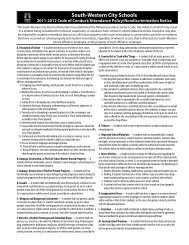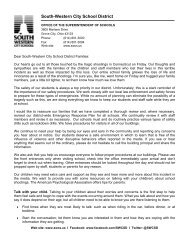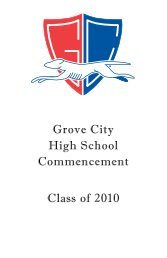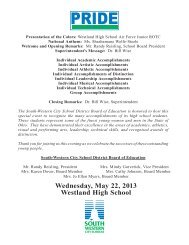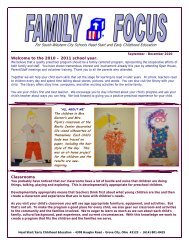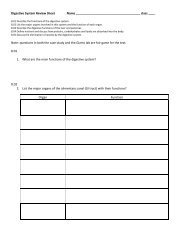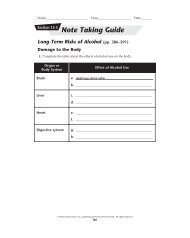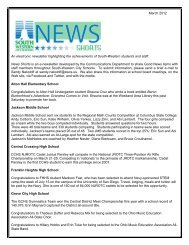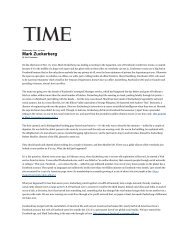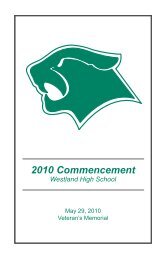3rd grade context clues.pub
3rd grade context clues.pub
3rd grade context clues.pub
Create successful ePaper yourself
Turn your PDF publications into a flip-book with our unique Google optimized e-Paper software.
<strong>3rd</strong> Grade<br />
Context Clues<br />
• Determine the meaning of<br />
unknown words using a variety of<br />
<strong>context</strong> <strong>clues</strong>, including word,<br />
sentence and paragraph <strong>clues</strong><br />
• Use <strong>context</strong> <strong>clues</strong> to determine the<br />
meaning of homophones,<br />
homonyms and homographs<br />
• Apply the meaning of the terms<br />
synonym and antonym<br />
• Apply knowledge of individual<br />
words in unknown compound<br />
words to determine their meanings
What Students Need to Know:<br />
• unknown words<br />
• <strong>context</strong> <strong>clues</strong><br />
• word <strong>clues</strong><br />
• sentence <strong>clues</strong><br />
• paragraph <strong>clues</strong><br />
• homophones<br />
• homonyms<br />
• homographs<br />
• synonym<br />
• antonym<br />
• compound words<br />
• meaning of words<br />
What Students Need to be<br />
Able to Do:<br />
• determine (meaning of unknown<br />
words, homophones, homonyms,<br />
homographs)<br />
• use (variety of <strong>context</strong> <strong>clues</strong>)<br />
• apply (meaning of terms synonym<br />
and antonym, knowledge of individual<br />
words found in compound words)<br />
Important Vocabulary<br />
antonym—A word opposite in meaning to another word (e.g., good and bad)<br />
compound word—A combination of two or more words that function as a single unit of meaning<br />
(e.g., bookkeeper or downtrodden).<br />
<strong>context</strong> <strong>clues</strong>—Information a reader may obtain from a text that helps confirm the meaning of a<br />
word or group of words<br />
homonym—A word with different origin and meaning but the same oral or written form as one<br />
or more other words, as bear (an animal) vs. bear (to support) vs. bare (exposed).<br />
Homonyms include homophones and homographs.<br />
homophone — A word with different origin and meaning but the same pronunciation as another<br />
word, whether or not spelled alike (e.g., hair and hare).<br />
homograph.– A word with the same spelling as another word, whether or not pronounced alike,<br />
as pen (a writing instrument) vs. pen (an enclosure) or bow (an arrow) vs. bow (of a ship).<br />
synonym—One of two or more words in a language that have similar meanings (e.g., answer<br />
and respond).
Context Clues<br />
Perhaps one of the most commonly used phrases by teachers when helping students figure<br />
out the meaning of an unknown word is, “Use the <strong>context</strong> <strong>clues</strong>.” The big question<br />
that arises from this practice is whether or not we’ve ever really taught students how to<br />
use the <strong>context</strong> <strong>clues</strong> to determine the meaning of an unknown word.<br />
Kylene Beers in her book When Kids Can’t Read has this to say about the strategy of<br />
using <strong>context</strong> <strong>clues</strong>: “. . . discerning the meaning of unknown words using <strong>context</strong> <strong>clues</strong><br />
requires a sophisticated interaction with the text that dependent readers have not yet<br />
achieved.” Many times the <strong>clues</strong> to the meaning are subtle and require the reader to<br />
make a lot of inferences. Context <strong>clues</strong> will often give the reader some idea of the<br />
meaning of a word, but they are not sufficient to determine an exact meaning. She goes<br />
on to make the following point: “I do think it means we must recognize that using the<br />
<strong>context</strong> as a clue is something that requires lots of practice, something that separates<br />
dependent from independent readers, something that is much harder than we may have<br />
realized.”<br />
Teaching students how to use the <strong>context</strong> as a clue requires that students see relationships<br />
among words and can make inferences about the passage. There are several different<br />
types of <strong>context</strong> <strong>clues</strong> that are commonly used by authors and warrant our teaching<br />
about them to students:<br />
Clues supplied through synonyms:<br />
Carly is fond of trite, worn-out expressions in her writing. Her favorite is "You can lead a horse to water,<br />
but you can't make him drink."<br />
Clues contained in comparisons and contrasts:<br />
As the trial continued, the defendant's guilt became more and more obvious. With even the slightest bit of<br />
new evidence against him, there would be no chance of acquittal.<br />
Clues contained in a definition or description:<br />
Paul is a transcriptionist, a person who makes a written copy of a recorded message.<br />
Clues through association with other words in the sentence:<br />
Brian is considered the most troublesome student ever to have walked the halls of Central High School.<br />
He has not passed a single class in his four years there and seldom makes it through an entire hour of class<br />
without falling asleep or getting sent to the office. His teachers consider him completely incorrigible.<br />
Clues which appear in a series:<br />
The dulcimer, fiddle, and banjo are all popular among the Appalachian Mountain people.<br />
Clues provided by the tone and setting:<br />
The streets filled instantly with bellicose protesters, who pushed and shoved their way through the frantic<br />
bystanders. The scene was no longer peaceful and calm as the marchers had promised it would be.<br />
Clues derived from cause and effect:<br />
Since no one came to the first voluntary work session, attendance for the second one is mandatory for all<br />
the members.
Mini-Lessons for Teaching<br />
Context Clues<br />
Working out what words mean<br />
• Look at how a new word is used<br />
• Look at the other words in the sentence<br />
• Look at the sentences before and after the new words
Test Questions from Past Tests<br />
This sentence is from the selection.<br />
“But these flakes rarely make it to the<br />
ground.”<br />
What choice means the same as rarely?<br />
a. hardly ever<br />
b. often<br />
c. sometimes<br />
This sentence is from the selection.<br />
“Many seahorses live in tropical areas<br />
where the water is always warm.”<br />
What does the word tropical mean in the<br />
sentence?<br />
a. a place that is very hot and often damp<br />
b. a place that gets cold during parts of the<br />
year<br />
c. a place off the coast of Alaska where<br />
seahorses breed<br />
What word is a synonym for fix?<br />
a. repair<br />
b. explain<br />
c. delay<br />
The following sentence is from the selection.<br />
“Taffy walked proudly into the yard.” What<br />
does proudly mean in the sentence?<br />
a. very shy<br />
b. very quick<br />
c. very pleased<br />
This is a sentence from the selection.<br />
“When my classmates came in, they were<br />
very surprised to see all of the lovely<br />
leaves.”<br />
Which word is the opposite of lovely?<br />
a. large<br />
b. ugly<br />
c. colorful<br />
What word is an antonym for thin?<br />
a. thick<br />
b. thing<br />
c. think<br />
This sentence is from the selection.<br />
“The disease made one of her legs very<br />
weak.”<br />
What does disease mean i this sentence?<br />
a. brace<br />
b. illness<br />
c. exercises<br />
This sentence is from the selection.<br />
“Digging around in the treasure box, I uncovered<br />
a ball of twine.”<br />
What does uncovered mean in the sentence?<br />
a. found<br />
b. buried<br />
c. threw out<br />
This sentence is from the selection.<br />
“’I think I forgot something,’ she said.”<br />
What word means the opposite of forgot?<br />
a. remembered<br />
b. caught<br />
c. undid<br />
What word is an antonym for awake?<br />
a. aware<br />
b. alone<br />
c. asleep<br />
This sentence is from the selection.<br />
“Gently, I dragged my hairbrush through Sable’s<br />
matted fur, careful not to pull.”<br />
What does the word matted mean?<br />
a. tangled<br />
b. torn<br />
c. colored<br />
This sentence is from the selection.<br />
“Other stargazers and astronomers gaze<br />
through telescopes.”<br />
What does the word gaze mean?<br />
a. study<br />
b. count<br />
c. look<br />
What is a synonym for close?<br />
a. howl<br />
b. shut<br />
c. climb<br />
What word is an antonym for huge?<br />
a. hard<br />
b. even<br />
c. tiny
This sentence is from the selection.<br />
“I was thrilled. I had never won a trophy before.”<br />
Which word means the opposite of thrilled?<br />
a. disappointed<br />
b. confused<br />
c. excited<br />
This sentence is from the selection.<br />
“They can leap from tree to tree. . .”<br />
What word means the same as leap?<br />
a. jump<br />
b. drop<br />
c. walk<br />
This sentence is from the selection.<br />
“Allie and Amy burst out of their doors together.”<br />
What does burst mean in the sentence?<br />
a. They walked slowly out their doors.<br />
b. They hurried out of their doors.<br />
c. They both broke their doors.<br />
This sentence is from the selection.<br />
“She slept in her special cot wrapped tight as<br />
a parcel.”<br />
What is another word for parcel?<br />
a. puppy<br />
b. package<br />
c. doll<br />
What word is a synonym for stop?<br />
a. skip<br />
b. end<br />
c. leave<br />
This is a sentence from the selection.<br />
“Joey carried her pail to the living room and<br />
settled into the window seat to watch from<br />
Gramp and Grandma.”<br />
What does the word settled mean?<br />
a. got bored<br />
b. got comfortable<br />
c. got tired<br />
These sentences are from the selection.<br />
“In 1868, Thomas received his first patent. It<br />
was for an electric voting machine. A patent<br />
is a special paper that proves that the invention<br />
is the inventor’s and no one else’s.”<br />
A patent tells people that<br />
a. an invention belongs to you.<br />
b. they can copy your invention.<br />
c. others can use your invention.<br />
This sentence is from the selection.<br />
“Rabbits get around by using their powerful<br />
hind legs.”<br />
What word means the same as powerful?<br />
a. weak<br />
b. large<br />
c. strong<br />
This sentence is from the selection.<br />
“Some smells are sweet . . .”<br />
Which word is an opposite of sweet?<br />
a. sour<br />
b. clean<br />
c. old<br />
What word is an antonym for noisy?<br />
a. drum<br />
b. praise<br />
c. quiet
Suggested<br />
Strategies for<br />
Teaching<br />
Context Clues
cloze activities<br />
Cloze passages encourage students to use <strong>context</strong> to figure out unknown words. The procedure<br />
is easy to carry out. A short passage of text is selected and copied or summarized<br />
on the board or a transparency. Several words are deleted, and students are guided to figure<br />
out the missing words by using the sense of the surrounding sentences.<br />
Marty’s mom walked over to the _____ of the pine tree. She undid the wire that keeps the fence<br />
_____, so she could get in. She crouched _____ in the pine _____, and Shiloh started to _____ up<br />
on her with his front paws. He licked at her _____.<br />
Students who have difficulty with this may be given banks of words from which to choose<br />
their answers; including three words in each bank usually works well.<br />
Marty’s mom walked over to the _____ of the pine tree. (tree, trunk, top)<br />
When an aim of the cloze activity is to help students learn to cross-check their use of <strong>context</strong><br />
with letter-sound <strong>clues</strong>, the beginning part of each omitted word can be provided.<br />
This limits students’ answer possibilities to words that fit the meaning of the sentence and<br />
begin with the appropriate letter-sound.<br />
Marty’s mom walked over to the tr_____ of the pine tree. She undid the wire that keeps the fence<br />
cl_____, so she could get in. She crouched d_____ in the pine n_____, and Shiloh started to<br />
l_____ up on her with his front paws. He licked at her f_____.<br />
Another variation might involve placing a sticky note on top of each blank. Students can<br />
then predict what words might work in the sentence. Then take off part of the sticky note<br />
to reveal the beginning letter and have students refine their predictions based on the first<br />
letter.<br />
Other ways to use cloze include:<br />
• Read a sentence to students, replacing one of the words with the word “beep.” Students<br />
try to determine what word should be used in place of the “beep.” Discuss how<br />
students were able to determine the missing word.<br />
• Write a sentence on an overhead and tape a piece of tagboard on top of one of the<br />
words. Students should read the sentence and try to determine the missing word.<br />
Have them write down the word that they think should be used in the sentence. Then<br />
flip up the tagboard to expose the missing word. Discuss why various answers might<br />
or might not be feasible in terms of semantic (meaning) and syntactic (sound right)<br />
<strong>clues</strong> in the sentence.<br />
• A variation of the activity above could involve covering the word with 2 pieces of tagboard<br />
— one over the first letter, and the other covering the rest of the word. When<br />
students have made their prediction about the missing word, uncover the beginning<br />
letter. Students then evaluate their prediction in terms of the first letter of the word.
develop vocabulary<br />
Points to Remember for Developing Vocabulary<br />
● Talk about words — interesting words, unusual words, new words, or old words with new<br />
meanings<br />
● Teach in <strong>context</strong> whenever possible<br />
● Teach students how to use <strong>context</strong> to figure out new words<br />
● Focus on just a few words at a time. It is better to learn three words well than to learn ten<br />
words superficially<br />
● Promote words. Maintain a wall chart with the three or four most interesting words students<br />
have read or heard this week<br />
● Think in terms of phrases and sentences and interesting sayings<br />
● Use literature as a model of how words can be used. Good authors are masters at choosing<br />
just the right word<br />
● Promote variety and versatility. Talk about how even a simple word can have many<br />
shades of meaning: for example, hit the ball, a hit show, hit the nail on the head, hit and<br />
run, hit the deck, and so on.<br />
● Compliment students when they use interesting language<br />
● Encourage students to use the <strong>context</strong> to predict the meaning of unknown words. Have<br />
them record unknown words on the chart on the following page, then ask them to predict a<br />
word’s meaning. Finally, have them check their prediction by looking up the word in a<br />
dictionary. The definition or synonym goes in the third column.<br />
find the key words<br />
Teach students to look for key words as they are reading. These are the words that will help<br />
them determine the meaning of unknown words. Highlighting or underlining the key words<br />
will help them use this information to determine meanings of unknown words.
vocabulary check<br />
New Word I Think it Means Definition or Synonym
survival words<br />
• Select several words from a text that may cause students trouble. These should be words<br />
that students are likely to encounter again as they are reading.<br />
• Have students create a chart like the one on the next page.<br />
• Students should copy the words in the first column of the chart and check the appropriate<br />
column indicating their familiarity with the word — not familiar, somewhat familiar, I<br />
think I know<br />
• Ask students to write the meanings of as many of the words as they know in the<br />
“Meaning” column<br />
• Have students read the selection, looking for the words on the chart. When they find a<br />
word, they should record the page on which it is found and confirm their predicted meaning<br />
from the <strong>context</strong><br />
• After students have rated their word knowledge, written their meanings, and read the<br />
text, break them into groups and ask them to share with each other the meanings they are<br />
most confident about<br />
• Finally, discuss the words with the whole group, answering questions and clarifying<br />
thinking.<br />
semantic mapping<br />
Using Semantic Mapping before and after reading will expand a reader’s word knowledge .<br />
It will also help the reader to see the relationships and interrelationships of words. It will<br />
help students build bridges from the known to the new.<br />
Procedure:<br />
1. Select a word important to the story<br />
2. Write it down<br />
3. Think of related words and list them in categories<br />
4. Name the categories<br />
5. Discuss the words and their relationships<br />
6. Read the story<br />
7. Return to the semantic map. Add new words and discuss the relationships<br />
Evaluation:<br />
• Are you able to use the vocabulary (word knowledge) to understand the passage?<br />
• Can you develop a meaningful paragraph using the instructional words and related<br />
word?<br />
Additional Suggestion:<br />
• Use semantic mapping as a vehicle to introduce or summarize a chapter or a thematic unit
survival words<br />
Word Page Not Familiar Somewhat Familiar<br />
I Think I Know Meaning
<strong>context</strong>ual analysis<br />
When supporting developing or struggling readers, it is important to help them remember that<br />
although we pay attention to the way a word looks when we read, we also must pay attention<br />
to how it is used in a sentence.<br />
Help students analyze new vocabulary by having them complete a graphic organizer that requires<br />
analyzing how a word is used in <strong>context</strong>. A blank is found on the next page.<br />
use the <strong>context</strong> <strong>clues</strong><br />
human <strong>context</strong><br />
<strong>clues</strong><br />
Play this game to help students learn<br />
which words are helpful in determining<br />
the meaning of an unknown word.<br />
1. Select a sentence with an unknown<br />
word.<br />
2. Write each word in the sentence on a<br />
separate index card.<br />
3. Hand each index card to a student and<br />
share with those students the sentence.<br />
4. Have the students arrange themselves<br />
so the sentence can be read from left to<br />
right.<br />
5. The student with the unknown word<br />
turns his card around so the other students<br />
can see it. The words on the<br />
other cards should not be revealed.<br />
6. Arbitrarily ask one student at a time to<br />
reveal his card. Discuss whether or not<br />
each word helps students determine<br />
the meaning of the unknown word.<br />
7. Continue until all words have been revealed.<br />
What does it mean?<br />
A reptile<br />
with a shell<br />
on its back;<br />
warmblooded<br />
tortoise<br />
Where we’ve seen or<br />
heard the word<br />
“The Tortoise<br />
and the<br />
Hare”<br />
Another word<br />
with a similar<br />
meaning<br />
turtle<br />
It is a _________<br />
___ Noun—<br />
person, place or<br />
thing<br />
___ Verb—action<br />
word<br />
____ Adjective—<br />
describing noun<br />
____ Adverb—<br />
describing verb
use the <strong>context</strong> <strong>clues</strong><br />
What does it mean?<br />
Another word with a<br />
similar meaning<br />
Where we’ve seen or<br />
heard the word<br />
It is a _________<br />
____ Noun—person,<br />
place or thing<br />
____ Verb—action word<br />
____ Adjective—<br />
describing noun<br />
____ Adverb—describing<br />
verb
multiple meaning words<br />
Words that have more than one meaning often present problems for students. These words<br />
usually don’t present any problems as far as decoding goes. They are words that are often<br />
familiar in a student’s oral language if they are native English speakers. However, for second-language<br />
learners, these words require many exposures in meaningful text before students<br />
feel as if they understand all of the different meanings.<br />
To call students’ attention to these words, follow these steps:<br />
1. Select three to five words to be taught in one lesson.<br />
2. Present the words on the board or overhead. Give the students the same words on cards.<br />
3. Use one of the words in a written sentence and ask the students to provide a meaning for<br />
the words. For example: (A) My mother asked me to set the table before dinner.<br />
4. After the students have agreed on a definition, present the same word in a new sentence.<br />
For example: (B) Jamie was always 10 minutes late for school, so his mother _____ the<br />
clock ahead 10 minutes.<br />
5. Ask students to hold up the word card that shows the word that best fits into the second<br />
sentence.<br />
6. Discuss how set is also the correct answer in sentence B. What definition can you give for<br />
set in sentence B? How is the meaning different for the word set in the two sentences?<br />
7. Ask the students if they can think of another definition for set or how they have heard<br />
people use the word in a different way. They may suggest set, as in “set the book on the<br />
table,” or set, as in “ready, set, go.”<br />
8. Repeat the steps for the other words for the lesson.<br />
The following chart lists some common multiple meaning words.<br />
From What’s After Assessment? p. 64<br />
about run spell can<br />
will down mean right<br />
page letter head saw<br />
state hard above band<br />
back set well have<br />
head bank high on<br />
by use book face<br />
miss side light last<br />
point left take off<br />
over home get cut
When to Use <strong>context</strong> <strong>clues</strong> and when not<br />
to use <strong>context</strong> <strong>clues</strong><br />
Context alone cannot substitute for direct vocabulary instruction. Some words will need<br />
to be taught before readers can comprehend a text. Some researchers found that students<br />
who read <strong>grade</strong>-level texts under natural conditions have about a one in twenty chance of<br />
learning meaning from <strong>context</strong>. Others agree that learning words through <strong>context</strong> <strong>clues</strong> is<br />
limited at best. They offer several cautions about word learning through <strong>context</strong>:<br />
• Context <strong>clues</strong> are a relatively ineffective means for inferring the meaning of specific<br />
words.<br />
• Students are more apt to learn specific new vocabulary when definitional information<br />
is combined with <strong>context</strong>ual <strong>clues</strong> than when <strong>context</strong>ual analysis is used in isolation.<br />
• Research on teaching <strong>context</strong>ual analysis as a transferable and generalizable strategy<br />
for word learning is promising, but limited.<br />
When determining which words should be directly taught, a four-step process may prove<br />
helpful:<br />
1. Determine what you want your students to learn from the reading of the content; in<br />
other words, the theme of the unit of study.<br />
2. Identify key terms that are related to the unit’s theme.<br />
3. Decide on appropriate strategies to introduce and reinforce the words (e.g., a graphic<br />
organizer)<br />
4. Identify the general words that are not necessarily central to the theme of the unit, but<br />
that lend themselves to various word-learning strategies that promote independence<br />
(e.g., modeling words in <strong>context</strong>)<br />
Another way to help you decide which words to teach is to ask the following questions:<br />
• Is understanding the word important to understanding the selection in which it appears?<br />
• If no, then you select other words that are more important.<br />
• Are students able to use <strong>context</strong> or structural analysis skills to discover the word’s<br />
meaning?<br />
• If yes, allow them to practice them.<br />
• Can working with this word be useful in furthering students’ <strong>context</strong>, structural analysis,<br />
or dictionary skills?<br />
• If yes, then focus on that<br />
• How useful is this word outside of the reading selection being currently taught?<br />
• The more frequent a word is, the greater the chances that students will retain<br />
the word once you teach it.
using <strong>clues</strong> to figure out meanings of<br />
words<br />
Sometimes readers can figure out word meanings from the <strong>context</strong> or from their prior<br />
knowledge of a concept. Below are some strategies students can use to figure out the meaning<br />
of a word by using <strong>context</strong> <strong>clues</strong>. These should be taught to students..<br />
• Reread the sentence. Look for ideas and words that offer meaning <strong>clues</strong><br />
• Read the sentence without the word<br />
• Can you figure out what word you know that would make sense in place of the<br />
unknown word?<br />
• Look at the word in relation to the sentence and full paragraph.<br />
• Can you figure out a meaning?<br />
• Read the two or three sentences that came before the one that contains the unfamiliar word(s).<br />
Look for meaning <strong>clues</strong> (i.e., synonyms or antonyms).<br />
• Read the two or three sentences that come after the one that contains the unfamiliar word(s).<br />
Look for meaning <strong>clues</strong> (i.e., synonyms or antonyms).<br />
• Look at the page where the word is located<br />
• Is there an illustration or diagram that helps with the meaning of the word<br />
• Find the base or root word and think of its meaning.<br />
• See if the prefix can help you understand the word.<br />
• Ask yourself: Have I seen or heard this word in another text or situation? What do I recall?<br />
• Think of the overall meaning of the selection you are reading. Does your understanding of the<br />
whole help you figure out particular words?<br />
• Ask a classmate if he/she knows the meaning of the word<br />
• Look the word up in a dictionary<br />
• See if any of the meanings fit the sentence<br />
• As a last resort, ask your teacher or other adult.




